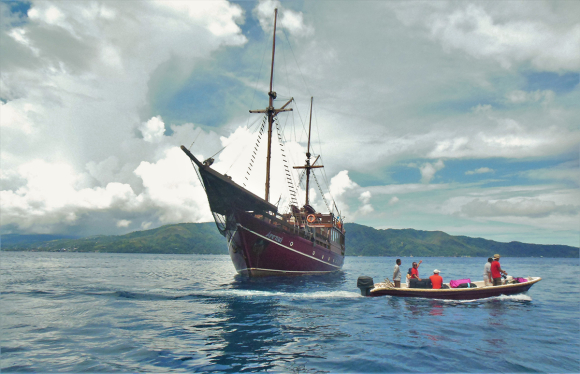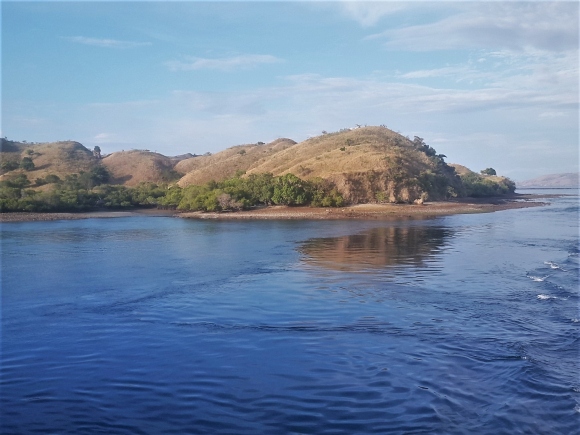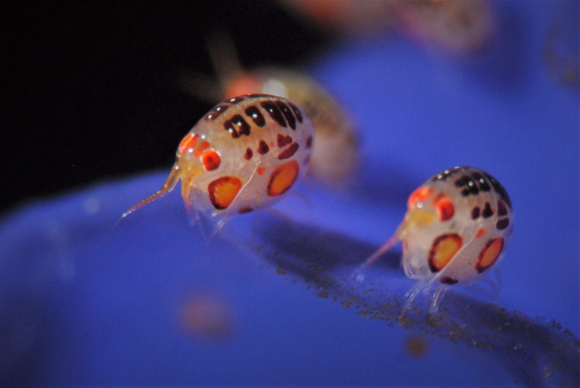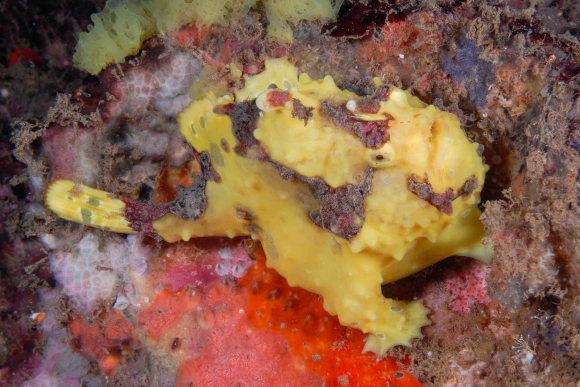Liveaboard in Indonesia
Indonesia i the Far east is a very large country and for many quite unknown. In addition to a rich culture, fantastic food, friendly people, wonderful beaches, great shopping, beautiful nature and exciting experiences on land, Indonesia also has fantastic diving. Liveaboard in Indonesia is a concept that has grown greatly in recent years and the opportunities for good diving are fantastic. I list some of the different places that can be experienced with a liveaboard in Indonesia.
Over 16.000 islands in Indonesia
Diving is available all over the country, but it is very varied. Depending on where you go on a liveaboard in Indonesia, you will see different types of marine environments. Few places can offer it all, but here are big animals like blue whales, sperm whales, dolphins, killer whales, whale sharks, white sharks, tiger sharks, hammerhead sharks to the smallest crustaceans, nudibranchs of a few millimeters, pygmy seahorses and lots of other small things that attract UV photographers from all over the world. the world. Macro diving is perhaps the most famous and best in the world together with the Philippines but as I said. There is almost everything to experience here including wreck diving and caves.
Here there are shallow waters and bays with a depth of just under ten meters to the world's deepest place that is not a deep-water grave. The web depth west of Papua is over 7200 meters deep! This is also why diving trips with liveaboards in Indonesia have become extremely popular and the diving industry is growing all the time. Hang on to a tour and then when it's time to book, you'll know more about where to go on your next dive cruise.
Komodo - island of dragons
One of the first places in Indonesia there liveaboard became popular and big is in Komodo. Komodo National Park is probably best known for its large monitor lizards that are only found here on Komodo and a couple of neighboring islands. You can get here in two ways. Either you fly from Bali or Jakarta to Flores and from there your liveaboard starts here in Indonesia and to Komodo or you go with one of the liveaboards that start in Bali. You will miss a few days of diving on your diving cruise in Komodo, but the diving in the region is so good that it doesn't matter. Manta rays, whale sharks, eagle rays, hammerhead sharks and more are often seen along the islands here on the way to Komodo.
The volcano Sangeang, which is almost 2000 meters high and very active, is located just northwest of the national park near the island of Sumbawa and has absolutely incredible diving. Dark black volcanic sand teeming with marine life and colorful nudibranchs. Incredibly beautiful corals and individual coral blocks are scattered and create a nice labyrinth to dive in and discover on your own or with a guide. Here you can also see gas rising out of the sand as bubbles and it feels a bit like diving into a champagne glass. Inside national parks you will find wall diving with outstanding corals, coral reefs and lots of fish.
The sea tilts in the strong current
One of the places is so current that I have to dive in the lee of the wall so as not to go with the current. It's so current that I can actually see the water tilting downwards when I'm standing on the liveaboard. Water from the Pacific Ocean is pushed down here through the narrow straits by the Indonesian islands and brings loads of nutrients down to the Indian Ocean and creates these incredibly powerful currents.
Down at the southern part of Komodo, we dive at manta alley. Just as it sounds, there are plenty of manta rays here. These huge fish glide over the reef and here they have a grooming station which means they come here daily. Here, too, the water is very fast, so it is important to plan the diving well. Another spot offers manta rays gliding over the white sandy bottom. Here, at the end of a long sandy plateau where we saw lots of nudges, lots of manta rays come and allow themselves to be preened. There are also plenty of slightly larger fish standing in shoals with their heads against the current, waiting for something edible.
Unprecedented splendor of color at Horse shoe bay
At the southern part of the island of Rinca is horse shoe bay. Here in a large bay is the island of Kode and between the two islands a lagoon or horseshoe-shaped bay is formed. Here at the cannibal rock dive site, the diving is absolutely outstanding. Corals, anemones and hair stars cover every millimeter of the rocks and form a mosaic that I have not seen anywhere else in the world. Here we also get to see the fantastically beautiful sea cucumber called sea apple. They sit directly on the rocks and filter nutrients and are truly incredibly beautiful. Add nudibranchs and little lady bugs hopping around on the azure sea urchins and you have a macro paradise that is truly unique.
A Liveaboard in Komodo here in Indonesia should be on every diver's bucket list because the diving here is incredibly spectacular and with healthy and thriving coral reefs. In my opinion actually better diving than Raja Ampat but that is probably a matter of personal taste.
Raja Ampat - the most popular liveaboard in Indonesia.
For about half a year, roughly the period November to March, that is Raja Ampat in the western part of Papua Barat under high pressure from diving tourism. One diving resort after another pops up here and nowadays this fabulous area is visited by close to a hundred different liveaboarders every year. During the high season here, it's almost strange that you don't see more boats than you do during the tours. The area is large and everyone has their favorite places and routes. The diving cruises also vary in length depending on which boat you go with. Normally the cruises are seven to fourteen days and all offer diving and full board on board. The standard and size of the boats varies greatly. Some boats are super luxurious while others are much simpler.
The diving in Raja Ampat is amazingly rich in species and here in West Papua you have a paradise for macro life. Corals that you don't see in many other places in the world. Enormous amounts of hydroids so it can burn a little from time to time when so-called "no see's" drifting around in the sea hit uncovered cheeks, lips and hands. These microscopic particles can be a scourge after days of harsh weather causing them to detach from their host. A very good reason to have a one-piece suit that covers most of the body is clearly recommended.
Macro paradise
Here you will also find flat worms, nudges and at "The Passage" I probably found at least one new nudge or flat worm every meter. Absolutely incomparable once the eyes get up to speed here. Otherwise, this is a dive site where it is stream diving in its most awesome form. A long channel between some islands that pushes through the tide and you float forward at shallow depth and all around to quickly hide in the lee and admire the marine life before I take off again and fly some more.
Raja Ampat and West Papua are also known for places where whale sharks and manta rays are almost always seen, which naturally attracts many divers. Some species you often see are various reef sharks, thresher sharks, silvertip sharks, epaulette sharks, catsharks and the very spectacular wobbegong that is common here. If you're lucky, you can also see hammerhead sharks and tiger sharks. Various species of whales and dolphins are quite common and the reefs here are rich in marine life and many different species of fish. Raja Ampat is a must sooner or later for a diving trip. The mantas at Manta Sandy are a magical experience and here you can make long dives if you don't suck in too much air. The manta rays are large and come close to being cleaned at the various cleaning stations here.
The Moluccas with Halmahera and Ambon
Between the islands of Sulawesi and New Guinea are the Spice Islands or group of islands The Moluccas. Here is still quite unexploited but diving is slowly growing more and more. Liveaboarders in this part of Indonesia often stop and offer diving around the island of Ambon. Here you will find exceptionally good and varied diving. Over the years, Ambon is clearly best known for its incomparable macro diving. But there are also very beautiful and fine reefs on the outside of the horseshoe-shaped island. Sometimes you see big fish and even schools of hammerhead sharks here. Here at Ambon you sometimes also find the very strange psychedelic frogfish at certain times of the year.
If you like frogfish, Ambon is perhaps one of the world's best diving spots. Further north is the large island of Halmahera and here more and more liveaboarders are now starting to try diving. Some places around Halmahera offer very good macro diving, but it is probably the amount of large fish that attracts and sharks and various rays are often seen here. On the eastern side of the island there is a permanent liveaboard that runs almost all year round. Here in the flowing waters between the islands you often see large quantities of manta rays.
Good to be used to or prepared for stream diving
The waters between the small islands are channeled here and many places have real flowing water. To get the most out of your diving trip here, you should have experience with current diving and using a reef hook. There are particularly noticeably strong currents here at the Moluccas so for a liveaboard in Indonesia it is probably one of the least visited areas. However, the diving is magically good and it is of course possible to dive where the current is not as strong. For those of you who have done diving trips with liveaboard in Indonesia before but have not visited the Moluccas, this area is clearly worth a visit. It's at least as good as Raja Ampat and actually with lower prices on liveaboards here. Some tours with liveaboards even go around Ambon and the islands here. They are always done in connection with the so-called transition trips.
Transition trips
The ultimate liveaboards in Indonesia that have become increasingly popular are so-called transition trips. Trips undertaken to, for example, move the liveaboard from Komodo to Raja Ampat. Or from Raja Ampat to Sulawesi to renovate the boat and then back the same distance. Typical tours are Bali to Flores, Flores via the Banda Sea to Ambon and then Ambon to Raja Ampat. Then the tours go back next year in the spring when Komodo has its season again. In the past, the boats were empty when they were moved, but nowadays they can offer tours that are extremely exclusive as they only go once or twice a year in total. Perfect for a liveaboard in Indonesia for those who have "done it all"
If you do a diving trip like this with a liveaboard in Indonesia, you will reach places that you don't have a chance to get to if you live on land or on normal liveaboards. Several of these places can offer experiences that are like fairy tales. Large shoals of hammerhead sharks, small islands with thousands of snakes, places known for whale sharks. A tour in the Banda Sea passes by the small volcanic island of Gunung Api (fire mountain) which is truly in the middle of nowhere. The island rises from a depth of about 4000 meters and offers one of the world's best places for macro diving and large animals at the same time.
Other liveaboard routes in Indonesia that are not so common
Triton Bay
Off West Papua lies Triton Bay and here one or two times a year some liveaboarders go to an area known for whale sharks. But also shoals of hammerhead sharks and other large fish and huge shoals of tuna and barracuda. The corals are healthy and often they stand almost parallel to the flowing waters that often press here. These are usually quite shallow dives but you should have experience to dive here as you are beyond most. The nearest pressure chamber is at least two days' journey away. Today there are a few diving resorts here, but otherwise it is liveaboard that applies to get here.
Alor and Flores
The islands Alor and Flores in the eastern part of Nusa Tenggara are very pristine environments and very species-rich. Alor has long been referred to as one of the world's best diving destinations for both macro and large animals. The waters are rich in marine life and here you often see large animals such as manta rays, blue whales, humpback whales, sperm whales, pilot whales, whale sharks, hammerhead sharks, various reef sharks, nurse sharks, wobbegongs, pufferfish and many other large species.
The corals are fantastically well-being and an enormous number of different species. In the cold and current waters, this is perhaps one of the most beautiful and prosperous coral reefs you can find in the world. The species richness is enormous and the diving is very varied. Typical tours go here and then go on over the Banda Sea, and you only pass here a couple of times a year. Alor was for a long time quite noisy to get to, but today there are liveaboards that pass here a few times a year and there are also flights here and some diving resorts.
Forgotten Islands
out in the Banda Sea is a group of islands that are rarely visited. Here it is known for whale sharks and they are common here. Also shoals of hammerhead sharks and various reef sharks are almost always seen here. The macro life is outstanding and it's easy to forget to keep your eyes on the blue sometimes. The islands are very remote and are usually only visited in the spring or autumn when the boats run their so-called transition trips between the northern and southern parts. Sometimes you drive here in combination with Triton Bay
Cenderawasih Bay
lies far to the east on the northern side of Papua Barat. It takes a full day's sailing east of Sorong in Raja Ampat to get here. Cenderawasih is a very large bay on the north side outside the town of Nabire. You only go here to see whale sharks. They come into a pontoon in the middle of the huge bay where small fish (Ikan Puri) are kept. These small fish are caught during the night from about 60 meters deep. Every day the whale sharks come here and try their best to eat from the fishing nets. The men who fish often feed the whale sharks that come in here. Until recently, this area was completely unknown even though whale sharks have been known here for over 30 years.
There used to be a diving resort here in the area, but unfortunately it had to be closed for various reasons and internal conflicts in the area. You can only get here today with a liveaboard. The tours may run every few years, so they are not common. The diving here in general is not particularly remarkable. You can see some reef sharks and corals and some fish. Otherwise, the reefs are quite broken due to the exposed position from the forces and impact of the sea.
Derawan Islands
is outside Borneo and here you have very good macro diving. Japanese photographers often go here to see different species of gobis that are common here. Some places around Maratua Atoll just a little further south are also known for big fish and huge shoals of barracuda and tuna. Here you have a good chance of seeing different species of sharks as there is often a current. Reef sharks will swim towards you and pass you along the reefs and walls. With a bit of luck, manta rays and eagle rays might fly by too. The island of Sangalaki was many years ago the first to offer diving here in the Indonesian part of Borneo. It was hundreds of mobulas directly outside the resort that made diving tourism here take off.
Today, the area is easiest to experience with a liveaboard or from a diving resort nearby. Another exciting and different experience is Kakaban lake with its hundreds of thousands of jellyfish in a lake in the middle of the island. Only a few boats go here and more as a complement to other tours. For diving travelers who want to see and experience something new, it is a nice trip.
Lembeh Straits
A few weeks a year, several liveaboards usually offer a week's diving at magical times Lembeh Straits at North Sulawesi and just outside the city of Manado. Lembeh Straits is a strait in North Sulawesi known for its amazing macro diving. Here you often find different species of squid, nudibranchs, strange scorpion fish, flatworms and, odd species of fish. For example frogfish, ghost pipefish and various species of gobies and blennies as well as many other fun and strange things. The bottoms here are mostly sand, mud and mud, but you will still find here all the strange animals that have made Lembeh known in the diving world as a paradise for underwater photographers.
There are also some very nice reefs here and sometimes you can dive on the outside of the strait. There it is more traditional reef diving and sometimes you can see different species of sharks and stingrays and more. All dive sites can be reached by boat directly from the diving resorts here and the area is not really very large. A few liveaboarders run these tours for a week or so because they have long distance customers who are happy to do this. The tours take place as always in connection with the fact that you have had or will have the boat docked for maintenance in the city of Bitung.
Summary when you book
Diving trips with liveaboard in Indonesia are almost always very good. The diving in Indonesia is in a class of its own, the food is generally fantastic and good. The staff on the boats are so helpful that you hardly need to do anything. It really is dive, eat, sleep that applies here. The dive guides are outstanding and many times you wonder where their eyes are made. For those who like liveaboards, Indonesia is an absolute must and not just once. You can go here again and again as there is so much to experience. This is really good adventure and vacation. So now the question is where should I go next? and where do you want to go? Book your liveaboard to Indonesia directly here!











































